Research
Sakata Seed Corporation is a research and development corporation. For Sakata Seed Corporation, research is fundamental for its business. To develop superior future-oriented flower and vegetable varieties, we have created a global research system by establishing research stations and facilities in 21 locations across 13 countries, including Kakegawa Research Center in Shizuoka Prefecture in Japan, the USA, France, India, and Brazil and so.
Research Subject
At Sakata Seed Corporation, research consists of various processes that are necessary for developing new superior varieties. These include breeding flowers and vegetables and the processes that are necessary to do so, such as gathering materials and plant pathology. Especially, breeding—which refers to developing new varieties—is one of Sakata Seed Corporation's great strengths. Some of our major breeding subjects include broccoli, tomato, sunflower, and lisianthus.
Breeding
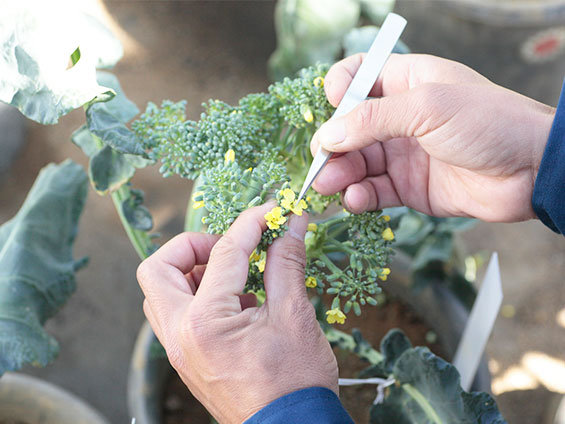
A process that requires steady effort where each and every flower is cross pollinated by hand. The photo shows a broccoli flower
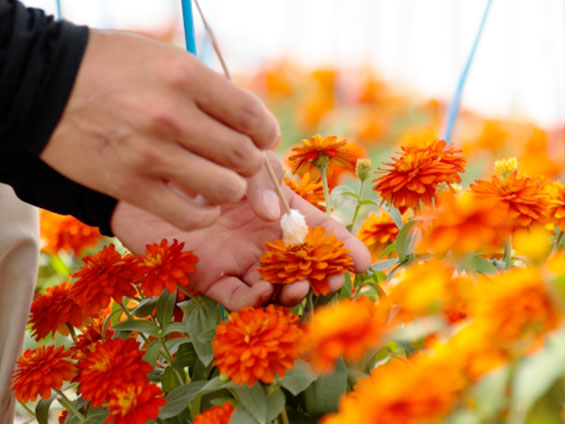
A process that requires steady effort where each and every flower is cross pollinated by hand. The photo shows a Zinnia flowers
We choose seeds from the extensive genetic resources that Sakata Seed Corporation has accumulated throughout its history. We then sow, cultivate, and screen them, and finally, we collect their seeds. We repeat this process to create parental lines. After that, we cross pollinate different parental lines and collect their seeds. By repeating this process, we create new superior varieties that have the desired characteristics and properties.
The process of identifying candidates for new varieties is important for breeding, but breeding is also believed to be about growing many varieties, discarding, and sorting them to only keep the superior varieties.
The strengths of Sakata Seed Corporation’s breeding
Sakata Seed Corporation’s breeding has three major strengths.
-
We have an abundance of flower and vegetable genetic resources.
-
Breeders with excellent technology and expertise are active worldwide.
-
We promote plant pathology research to support breeding.
1. We have an abundance of flower and vegetable genetic resources.
The first step of breeding is choosing the parent material from the abundant genetic resources. It is important here to appropriately store and manage these abundant genetic resources. In addition to our own genetic resources that we have collected and developed throughout the long history of Sakata Seed Corporation, we also access many genetic resources through various methods, such as utilizing native species and exploring genetic resources in collaboration with other countries. We apply our technology and expertise to appropriately handle these genetic resources and use them for breeding.
2. Breeders with excellent technology and expertise are active worldwide.
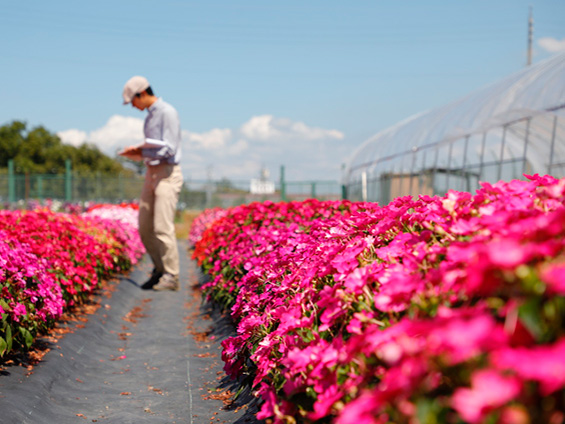
Breeding utilizes the breeder's experience and expertise. The photo shows a SunPatiens field

Breeding utilizes the breeder's experience and expertise. The photo shows a tomato greenhouse
The experience and expertise of the breeders when combining genetic resources, as well as their intuition and sense, play a great role in breeding. Breeding a new variety is said to take 10 years. Breeders have the foresight to predict the environment and the future of food in 10 years, and they have the creativity to come up with a variety of combinations. They also make a steady effort to sow and cultivate the seeds, cross pollinate them, then collect the seeds and screen them. It is not an exaggeration to say that breeders determine the success of breeding. At Sakata Seed Corporation, talented expert breeders are active worldwide. In addition, breeders actively exchange information regarding breeding and interact with each other.
3. We promote plant pathology research to support breeding.
Disease resistance is one of the requirements for having good varieties. Therefore, at Sakata Seed Corporation, we do the following steps in an effort to develop disease resistant varieties and support growers.
a. Implementing disease resistance breeding
b. Diagnosing diseases and offering preventive measures
a. Implementing disease resistance breeding
Diseases are generally caused by pathogens that are present in the place where the flowers and vegetables are cultivated, and develop when the environmental conditions are met. That is why Sakata Seed Corporation develops disease resistant flower and vegetable varieties to prevent diseases from developing.
For example, downy mildew causes serious damage to sunflower cultivation. Downy mildew has been increasingly developing in sunflower farms and its damage has been getting severe. Sakata Seed Corporation studied them well, and developed Vincent, an ornamental cut flower and the world's first sunflower that has resistance to downy mildew.

The sunflower bred as a Downy Mildew Resistant (DMR) variety to solve the downy mildew problem, Vincent (Type 2) Clear Orange DMR

The sunflower bred as a Downy Mildew Resistant (DMR) variety to solve the downy mildew problem, Vincent (Type 2) Tangerine DMR
b. Diagnosing diseases and offering preventive measures
If the disease develops on the farm, we identify the pathogen and offer the appropriate preventive measures. We also apply the disease information collected and analyzed in various farms around the world to cultivation suggestions.
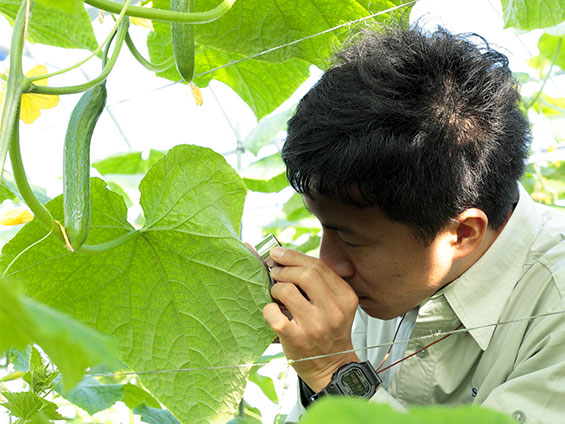
Diagnosing diseases to identify pathogens

Examining greenhouses and fields to locate pathogens
Research System
We have research stations and facilities in 13 countries around the world and we have established a global research system. Located in Japan, Kakegawa Research Center is vegetable and flower R&D station and is also the base for pathology and biotechnology. In addition to expanding our research activities, focusing on the local market at overseas research stations and facilities, we are also establishing a global technical cooperation system and realizing rapid and efficient product development.
The strengths of Sakata Seed Corporation’s research system
As a research and development corporation, Sakata Seed Corporation’s research system has a major strong point.
-
We have research institutes in 21 locations worldwide.
-
18% of our employees across the world are research staff.
-
We promote breeding using a team system.
1. We have research institutes in several countries worldwide.
We have research institutes in 21 locations in 13 countries worldwide. To utilize the advantage of breeding in areas near the actual cultivation sites of growers and home gardeners, we take into consideration climate, environment, soil, and food culture at its global research stations to research and develop varieties cultivated them worldwide.
2. 18% of our employees across the world are research staff.
Since Sakata Seed Corporation considers research to be the backbone of its business, it is no surprise that we have many research staff. In addition to our breeders, various researchers, including our staff who are involved in cultivation, pathology, and biotechnology, work daily with flowers and vegetables seeds with sincerity.
3. We promote breeding using a team system.
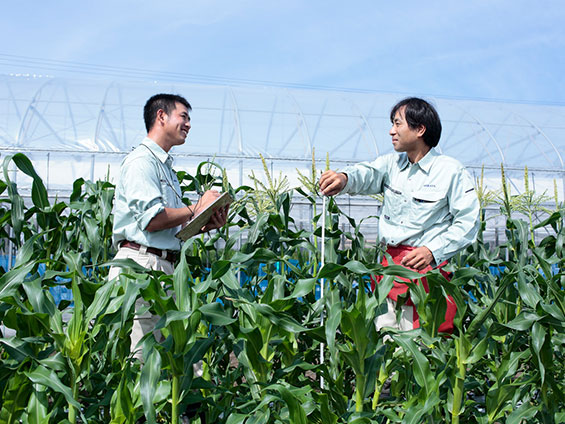
Improving breeding capabilities through our team system
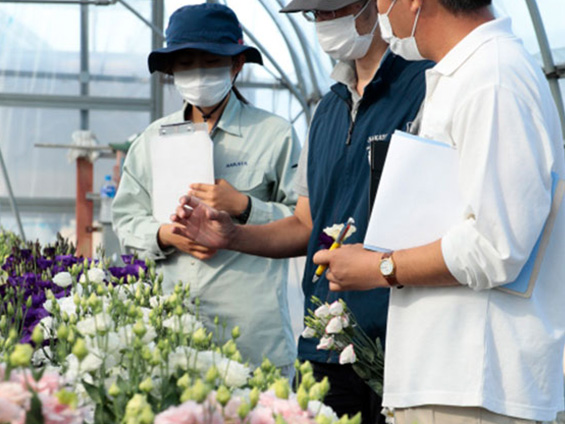
Examining cultivation results in greenhouses and fields
At Sakata Seed Corporation, breeders do not carry out the breeding process individually. Each crop is assigned to a team of breeders to carry out the breeding process. The advantages of the team system include encouraging communication and combining everyone’s different values, thus creating unique varieties. It also helps us pass down Sakata Seed Corporation's valued concepts and expertise of creating things to the younger generation while breeding varieties. The team system also helps with increasing the speed and efficiency of development, and maintaining a long-term perspective and continuity, which are essential for breeding.
It takes almost 10 years to carry out the breeding process and sell a new variety. However, at Sakata Seed Corporation, we continue to work hard, utilizing our three strengths—genetic resources, breeders and plant pathology research —and using cutting-edge biotechnology to reduce the breeding period and deliver to you superior varieties as soon as possible.